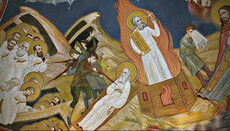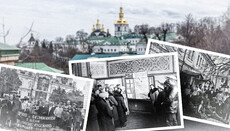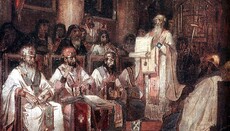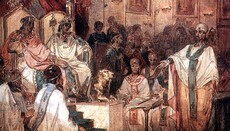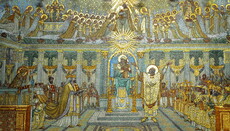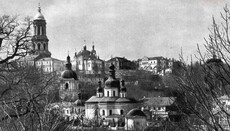New Martyrs of the 20th Century: Metropolitan Vladimir of Kiev
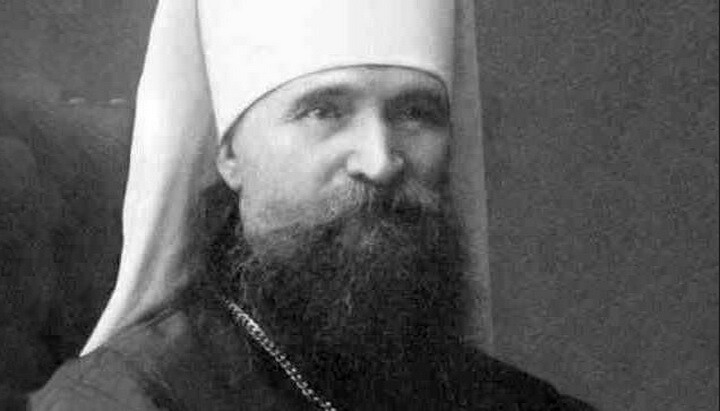
This man's life is a living testimony of Christ in situations where many would prefer to keep silent not to break the established order. His death is a worthy crown of such a life.
Metropolitan Vladimir (Bogoyavlensky) was the first hierarch to be martyred at the hands of the Bolsheviks. His death marked the beginning of the unprecedented persecution of the Church of Christ, which lasted a total of 70 years. Symbolically, it was in Kiev, where in 988 AD the Baptism of Rus took place, that in 1918 persecutions began, almost destroying the Church.
Early Years
We will say a few words about the life of the bishop before his episcopal ordination. He was born in 1848 in the village of Malo-Morshevka in the Tambov Governorate, to the family of a clergyman and was named Vasily. At the age of 9, he lost his father; and at 10, he entered a theological school, which he left in 1864 as one of the top students. Then he studied at the Tambov Seminary, where he also excelled, and in 1870, he entered the Kiev Theological Academy.
A distinctive feature of the future hieromartyr's character from childhood was shyness. On the one hand, this shielded him from the moral decline that prevailed in the dormitories of that time; and on the other hand, he found it difficult to get along with people, did not make friends, and did not trust those around him too much. This prevented him, in modern terms, from forming a team around him that could effectively implement his initiatives. Often, he had to go against the system alone, fight misunderstanding and unwillingness to change the usual course of things. He was also always distinguished by his desire to fulfil the commandments of Christ and to reveal the truth, whatever the cost. It can be said that he did not know how to adapt and seize opportunities, but at the same time, he was not a revolutionary in the broad sense of the word and did not seek to change everything.
He simply tried to fulfil God's will in the circumstances in which he was placed.
At the Kiev Theological Academy, Vasily Bogoyavlensky chose the Church-Practical Department, where sciences related to pastoral activities were studied: pastoral theology, homiletics, liturgics, church law, literature and foreign languages. In 1873, he defended his dissertation on the topic "On the Right of Church Excommunication", and in 1874, he graduated from the Academy with the degree of Candidate of Theology.
After graduating from the Kiev Theological Academy, Vasily Bogoyavlensky returned to his alma mater, the Tambov Seminary, where he taught homiletics, liturgics, canon law, the Scripture and the German Language. In addition, he taught geography at the eparchial women's school and in the women's gymnasium.
In 1876, Vasily Bogoyavlensky married Alexandra Saltykova, but he was ordained to the priesthood only six years later, in 1882. His first place of ministry was the Intercession Cathedral in the town of Kozlov in the Tambov Governorate, where he became an assistant to the rector. Within a year, Father Vasily was appointed the dean of the churches in Kozlov and the rector of the Trinity Church.
The first thing that surprised Father Vasily's parishioners was the live sermons he delivered rather than sight-reading as was customary.
The second surprise was his educational activities outside of worship. He organized meetings with people, pastoral talks and lectures. He aimed to instil in people a conscious faith in Christ rather than mechanically performing religious rituals. This activity immediately caused misunderstanding and quiet resistance among the clergy and many residents of Kozlov. However, over time, everyone saw Father Vasily's sincere desire to preach the Gospel to people. In 1883, at the initiative of Fr Vasily, the Brotherhood was established at the cemetery Cross Exaltation Church, which was engaged in charitable and educational activities.
In 1885, Father Vasily faced a severe trial – his wife died of tuberculosis, followed by his only child’s death. He perceived this as God's providence and, a year later, took monastic vows under the religious name of Vladimir.
The very next day after his tonsure, he was elevated to the rank of archimandrite and appointed the abbot of the Holy Trinity Monastery in Kozlov. Just a year later, he was transferred to the position of the abbot of the Novgorod Anthony Monastery and appointed a member of the Novgorod Theological Consistory. This reflected the spirit of the time. A person who had not spent even one day as a monk was appointed the abbot of a monastery. A priest, familiar only with family life, was put in charge of monks.
In most such cases, this brought nothing but harm to the monastic rank. However, in this case, the lack of experience in monastic labour was compensated by the high spiritual qualities of the future saint and his eagerness to preach the Gospel to everyone he encountered. In his new place of ministry, Fr Vladimir also began to hold non-liturgical talks, opened an eparchial library and organized religious-moral readings for the people.
In 1888, at the Holy Trinity Cathedral of the Alexander Nevsky Lavra in St. Petersburg, Archimandrite Vladimir was consecrated as the Bishop of Staraya Russa, the vicar of the Novgorod Eparchy.
The beginning of bishop's ministry
Vladyka Vladimir stayed on his first episcopal throne for a short time, about three years. He is remembered for holding spiritual and moral talks at St. Sophia’s Cathedral, organising the celebration of the 900th anniversary of the Baptism of Rus and transferring the wonderworking Icon of the Mother of God of Staraya Russa from Tikhvin to Staraya Russa. According to some sources, the icon appeared in Staraya Russa in 1470, while others claim it was in 1570.
It is known for sure that in 1570 it was temporarily transferred from Staraya Russa to Tikhvin, where an epidemic of pestilence broke out. According to the legend, the epidemic stopped, but for more than 300 years the people of Tikhvin refused to give the icon back under various pretexts, sometimes threatening with riots. The residents of Staraya Russa, accordingly, all these years were looking for a way to return the icon.
So, in 1888 the icon was returned with a solemn religious procession, which was met in Staraya Russa by Bishop Vladimir.
The Samara See
In early 1891, Bishop Vladimir was appointed as a ruling bishop to the Samara Cathedra. He spent less than two years in this position, but these years were very difficult and even tragic. As in his previous places of ministry, he was immediately concerned about the spiritual enlightenment of his entrusted flock. He held spiritual and moral talks, delivered public lectures and directly communicated with people of all classes and social standings.
In Samara, Bishop Vladimir not only personally held talks with the people but also strongly encouraged the clergy to do the same. He introduced the practice of reading the Akathist followed by a sermon and conversation in various churches of his eparchy. He read the Akathist himself, while the homily and the talk were entrusted to the priest. Moreover, he did not leave the church but sat on a bench and listened to the sermon like an ordinary parishioner.
Readings for the intelligentsia were held in the City Duma building and were so popular that the meeting hall could not accommodate all those interested. The bishop paid special attention to the education of children. By his efforts, about a hundred and fifty parish schools were opened. He considered the education and upbringing of children as the sacred duty of the clergy. In 1891, on the Feast of the Holy Equals-to-the-Apostles Cyril and Methodius, May 11, he established a holiday for all teachers and students. Pupils and students from all educational institutions were invited to the cathedral for a solemn service followed by a talk and the distribution of literature. Such activities of the bishop were not liked by many, and there were instances of quiet sabotage. For example, the celebration of the Feast of Saints Cyril and Methodius was only successfully organized at the second attempt.
In addition, Bishop Vladimir petitioned the Holy Synod to open a mission to educate the non-believers of the Samara Governorate. He also created the St Alexius Brotherhood to organise educational activities.
In 1892 two calamities struck the Samara province – the epidemic of cholera and crop failure. Bishop Vladimir responded wholeheartedly to the people's distress. He ordered to allocate the eparchial funds to help the needy. In Samara itself, as well as in each province city, he established church committees to raise funds and distribute donations. Canteens and tea rooms for the poor were opened at monasteries and wealthy parishes. All students and pupils of educational institutions were fed free of charge. The eparchy compiled lists of clergymen who were in special need of help, and later these lists began to include representatives of other classes as well.
When the cholera epidemic broke out, the bishop started serving molebens in the squares of Samara before the Smolensk Icon of the Mother of God. Risking infection, he visited infirmaries and hospitals, comforting the afflicted and providing them with assistance. When the number of deaths reached hundreds per day, Bishop Vladimir began to serve memorial services at the Samara cemetery.
However, not all residents of Samara were eager to help those in need. It was at this time that a young V. I. Lenin lived in Samara, just beginning his revolutionary activities. He and his like-minded comrades tried to use the famine and epidemic for their revolutionary purposes to foment people’s discontent.
One of Lenin's associates, V. V. Vodovozov, wrote in his memoirs: "Vl. Ulyanov (Lenin) sharply and decisively opposed feeding the starving. His position, as I remember it now — and I remember it well because I had many debates with him on this subject — boiled down to the following: hunger is a direct result of a certain social structure; as long as this structure exists, such famines are inevitable; they can only be eliminated by destroying this structure. ... He will make the peasant think about the foundations of the capitalist system, shatter faith in the Tsar and tsarism, and therefore, in due time, facilitate the victory of the revolution.”
Such was the situation in Samara at that time. However, the end of the famine and epidemic did not bring joy to Bishop Vladimir. He saw that the people were not reasoned and returned to their former sinful lives after the calamity ended. “Unfortunately, as soon as the wrath of God withdraws from us, the life of the city begins to take on the same appearance as it had before the affliction: the temples of God are empty again, the squares of the city are once again filled with disorderly dances and shameless songs,” he said after another service in the square in front of the cathedral.
Georgian Exarchate
On October 18, 1892, Bishop Vladimir was appointed the Exarch of Georgia with elevation to the rank of archbishop. This appointment could be aptly described as ascending to the cathedra as if ascending to Golgotha. The Georgian Church, according to tradition, was founded by the Apostle Andrew the First-Called, who gathered the first Christian community in the town of Atskuri. When Georgia became part of the Russian Empire in 1801, the Georgian Church enjoyed undisputed authority among the people and was governed by a Patriarch-Catholicos with a synod of bishops, as stipulated by canons. By that time, the Russian Church had been effectively integrated into the state apparatus for a hundred years, ruled not by a patriarch and bishops but by a secular official, the Ober-Procurator of the Holy Synod, acting on behalf and in the interests of the Tsar.
The Georgian Church was not treated with special respect: its autocephaly was abolished; the Patriarch was removed, leaving only two out of thirteen eparchies, which were integrated into the system of administration of the Russian Church with all the consequences that followed. It was quite natural that the Georgian clergy and laity did not favour the Russian Church and the Russian Empire in general.
Archbishop Vladimir understood all that perfectly, and although he was not an advocate for the immediate restoration of Georgian autocephaly, he did everything in his power for the benefit of the Georgian Church. To begin with, he learnt the Georgian language and served the liturgy in it. In 1894, he supported a report submitted to the Holy Synod by the Georgian community, which contained complaints about the oppression of the Georgian clergy and proposed steps to reform the administration of the Georgian Exarchate, including the appointment of a Georgian hierarch as exarch and an increase in the number of eparchies.
As before, the bishop carried out activities in the field of spiritual enlightenment: public readings, talks, the opening and provision of all necessary support for parish schools, the establishment of a brotherhood in Tiflis, and the opening of the Kutaisi Spiritual Seminary.
In addition, he was actively engaged in the restoration of churches. During his ministry in Georgia, about a hundred churches were built or renovated.
A year after his appointment to the Georgian chair, he had to face the same disaster as in Samara – a cholera epidemic. He also ordered funds to be allocated to help those in need, organized free dining rooms and tea houses for the poorest and visited hospitals and shelters. He performed public molebens in squares and organized processions in areas where cholera was most rampant.
Despite all this, Bishop Vladimir encountered resistance to his actions, a lack of understanding, and sometimes open hostility. Numerous slanderous reports against him were sent to the Holy Synod. Another new martyr, Protopriest Ioann Vostorgov, who also served in Georgia during these years, wrote: "...I knew about the hatred that surrounded the Exarch, about the slander directed against him, and how difficult his position was among the Georgian clergy. <...> His non-covetousness, simplicity, well-known diligence, integrity in everything, and especially his monastic chastity – everything about the Exarch was subject to suspicion and various slanderous reports.”
Moscow and St. Petersburg Sees
On February 21, 1898, Bishop Vladimir was appointed Metropolitan of Moscow and Kolomna. Here, all his usual activities continued, but on a larger scale. An active struggle against alcoholism was added. In 1911, he organized and held the All-Russian Anti-Alcohol Congress, followed by the All-Russian Congress of Practical Agents to Combat Alcoholism in 1912.
But most notable was his involvement in political activity, namely the fight against the revolutionary ideas that were increasingly capturing the minds of citizens. Truthful from childhood, he did not resort to diplomatic curtsey here and called things by their names. His message "What Should We Do in These Troubled Days" dedicated to the 1905 revolution was so sharp that the clergy hesitated to read it from the pulpits of their churches. A serious conflict arose, which was addressed at the level of the Holy Synod. The synodals agreed that it would be better not to publicise the message.
The bishop's attitude toward socialist and communist ideas boiled down to the following: the people have the right to demand social justice but should do so through lawful means.
The 1905 revolution also triggered a reform of church administration that had been maturing for several centuries. The key points of this reform were the convening of a Local Council, which hadn't happened in 200 years, and the election of a patriarch. To organize the Council, for which there wasn't yet the Emperor's consent, the Pre-Council Presence was convened at the Holy Synod in 1906. Archbishop Sergius (Stragorodsky) of Finland, the future patriarch, became the chairman of the Presence, and Metropolitan Vladimir (Bogoyavlensky) became his deputy.
On November 23, 1912, Metropolitan Vladimir was appointed to the St. Petersburg See and became a leading member of the Holy Synod. This position did not grant any special powers but rather served to somewhat disguise the fact that the Church was governed by a secular official. In the capital, the bishop's spiritual and educational activities continued, as did the fight against alcoholism. In particular, he secured the establishment of the All-Russian Sobriety Day on the Feast of the Beheading of John the Baptist. He met the outbreak of World War on the Metropolitan Throne. Metropolitan Vladimir established an eparchial fund to aid the families of soldiers, a 70-bed military hospital and a committee to assist refugees. He did everything in his power to ease the suffering of people during the war.
But an even greater test was the so-called Rasputinshchina. Historians to this day cannot reach a unanimous opinion regarding the personality of Grigory Rasputin and the extent of his influence on state and church affairs. Some consider his impact insignificant, while others claim that Rasputin could dismiss any bishop or minister and appoint another in his place.
Anyway, Metropolitan Vladimir (Bogoyavlensky), the leading member of the Holy Synod, considered Rasputin's activities to be very harmful to the Church and the state. In 1915, he managed to secure an audience with Emperor Nicholas II and expressed to the Tsar face-to-face everything he thought about Rasputin.
Active participant in all those events, Metropolitan Anthony (Khrapovitsky), later wrote: "At a time when others completely lied and constantly changed their convictions, Metropolitan Vladimir was not afraid to speak 'the truth to tsars,' and not 'with a smile' as our ancient poet said, but with tears, consciously subjecting himself to sorrows and sufferings, and at the same time enduring all life's troubles with humility and the greatest steadfastness of soul. Yes, he was a living example to our bishops, often experiencing in recent years the struggle between truth and benefit, between conscience and the honour of men—a model of how the former should be preferred to the latter!"
Some sources claim that the Tsar agreed with the bishop's opinion but mentioned that the Empress would never allow Rasputin to be offended. Shortly after the audience with Nicholas II in November 1915, Metropolitan Vladimir was removed from the Petrograd See and sent to Kiev, seen as an honorary exile. However, he retained the title of the first-ranking member of the Synod.
Kiev Golgotha
In Kiev, Metropolitan Vladimir had to deal with problems related to the occupation of part of the Ukrainian territory and revolutionary turmoil. As the leading member of the Synod, he often had to travel to Petrograd, where he spent a significant amount of time. This caused dissatisfaction among the Kiev clergy and laity. Metropolitan Vladimir witnessed the February and October revolutions of 1917 in Kiev.
After the abdication of the Tsar and the establishment of the Provisional Government, most members of the Holy Synod resigned, including Metropolitan Vladimir. Upon his return to Kiev in March 1917, the bishop found out that, in his absence, the so-called Executive Committee of Clergy and Laity had been set up, attempting to seize control of the church administration with the support of the Central Rada. Metropolitan Vladimir rejected the claims of the Executive Committee, referring to it as an unauthorized institution.
In April 1917, when the bishop was forced to leave for Petrograd again, an eparchial congress was held in Kiev, forming a new body called the Eparchial Rada (Council). The assembly also passed a resolution stating that "in autonomous Ukraine, the Ukrainian Church should be independent of the Synod”.
According to some sources, Metropolitan Vladimir gave his blessing for the convention of this congress but opposed its ideas about autocephaly.
However, the assembly did not make any specific decisions and decided to hold the next congress in early August 1917, which was attended by Metropolitan Vladimir personally. He had to endure so many insults and slander against him that he fell ill for several days. On August 15, 1917, he travelled to Moscow, where the Local Council of the Russian Orthodox Church opened, and the bishop was an honorary Chairman.
On 23 November 1917, the All-Ukrainian Orthodox Church Rada (AUOCR) headed by Archbishop Alexius (Dorodnitsyn) was established in Kiev. This hierarch had been the Archbishop of Vladimir and Shuya but was removed from the office by the Holy Synod in the spring of 1917 at the request of the clergy and laity of his eparchy for his despotic administration methods, rough treatment of the clergy and accusations of close ties with G. Rasputin. It is easy to guess that all these factors made him an enemy of Metropolitan Vladimir.
In the autumn of 1917, Alexius (Dorodnitsyn) arrived in Kiev and unilaterally settled in the Kiev-Pechersk Lavra. Having grasped the political situation, on the wave of autocephalous sentiments, he tried to seize church power and depose Metropolitan Vladimir.
The main goal that the AUOCR set for itself was to convene an All-Ukrainian Church Council. Dorodnitsyn and his associates assumed that this Council would vote for autocephaly. On November 6, 1917, the AUOCR sent a letter to Metropolitan Vladimir, who was in Moscow, urging him not to return to Kiev and to resign from the position of Metropolitan of Kiev.
However, the bishop refused to do so, and on December 2, 1917, he arrived in Kiev and settled in his Metropolitan residence in the Kiev-Pechersk Lavra. Alexius (Dorodnitsyn) was already residing in the Lavra, having managed to turn some monks against Metropolitan Vladimir.
Paradoxically, the Local Council of the Russian Orthodox Church in Moscow did not object to holding the Council in Kiev and even sent a delegation headed by Metropolitan Platon (Rozhdestvensky) there. The sessions of the Council opened on January 7, 1918, at St. Sophia's Cathedral in Kiev. Metropolitan Vladimir was elected honorary сhairman, while the actual chairman was Bishop Pimen (Pegov) of Balta. This might have happened because Metropolitan Vladimir was initially against the Council but gave his blessing for the sake of church peace.
At the first session, the Council decided to defrock Archbishop Alexius (Dorodnitsyn) for disobedience to the ecclesiastical authorities and violation of canons. Regarding the autocephaly of the Ukrainian Church, there were many debates, but a final decision was not reached. They decided to postpone this issue until May 1918 when the second session of the Council was planned.
The break in the Council's work was because Bolshevik forces were advancing on Kiev, and the city was under heavy shelling. After Kiev was captured by the Bolsheviks on January 23, 1918, they unleashed a real terror with mass killings and looting.
Martyrdom
The Kiev-Pechersk Lavra was also subjected to violence and looting. Red Army soldiers roamed through the churches and cells, committing sacrilege, mocking the brethren, and seizing whatever they could lay their hands on. On the evening of January 25, 1918, five armed individuals entered the Metropolitan’s chambers, demanding that the hierarch dress and follow them. Metropolitan Vladimir already understood that he was being led to execution. He spoke about this to some monks present there, blessed them, and bid farewell to his cell attendant.
He was led out of the Lavra through the Economic Gates and executed not far from the Lavra wall. After the bishop fell, he was stabbed several times with a bayonet, and then he was robbed. Before his death, he prayed and forgave his murderers.
On the morning of January 26, 1918, the body of the hieromartyr was found by passers-by. This means that the monks of Lavra and the people who were near the Metropolitan did not even enquire about the fate of the bishop and did not follow him at least from afar. and much less they tried to protect him from the Red Army soldiers. Perhaps, this can be explained by the atmosphere of fear prevailing in Kiev in those days. The body of the holy martyr was examined by medical professionals, dressed in episcopal vestments and placed in St. Michael's Church.
On January 29, 1918, the memorial service over Metropolitan Vladimir took place in the Dormition Cathedral of the Lavra. The hierarch was buried in the Cross Exaltation Church in the Near Caves. In 1992, Hieromartyr Vladimir was canonized, and his relics were discovered and now rest in the Far Caves of the Kiev-Pechersk Lavra.
Conclusion
What is the significance of the feat of the Hieromartyr Vladimir of Kiev for us, his descendants? First and foremost, it serves as an example of righteous life. There is an that in our time it is impossible to live according to the commandments of the Gospel, that it contradicts the pace of modern life, the rules of the world we live in, etc. This is what they say now, but it has always been said throughout history. At all times, those who did not want to live according to the Gospel justified themselves with such arguments. Yet, the righteous who lived alongside such self-justifying people were living testimony that in any epoch, under any circumstances, one can live according to God's commandments.
Metropolitan Vladimir not only lived in a challenging period, but he also held high positions in the church hierarchy within a decidedly anti-ecclesiastical system of church governance, where the Church had neither a patriarch nor a synodal administration. It completely submitted to the will of the monarch and depended on the person of the Ober-Procurator of the Holy Synod, de facto leading the Church. We see in Metropolitan Vladimir not a rebel against this system but a humble labourer in the field of Christ, who did everything possible to bring the good news of Christ to people. Despite all the difficulties and contradictions of the life of that time, he saved human souls and fulfilled not formally but effectively the words of Christ to the Apostles:: "...go and make disciples of all nations, baptizing them in the name of the Father and of the Son and the Holy Spirit, teaching them to observe all that I have commanded you..." (Matthew 28:19-20).
He went to squares to preach about Christ; he gathered people in churches and the halls of various institutions. He was not afraid of uncomfortable questions that could be asked (and such questions were very often raised under the influence of revolutionary sentiments). He could have lived a calm, measured life of a Russian bishop and not gone beyond the accepted behaviour at that time. But he was aflame with the spirit, burning with love for God, and that is why he could ignite the fire of faith in people's hearts.
Another lesson that Hieromartyr Vladimir teaches us is the fearless confession of truth before those in power. The bishop could not, for example, be unaware of the dangers his stand against Rasputin entailed, but he considered it his duty to do so.
Finally, his martyrdom shows us an example of how a true Christian should face death: calmly, fully surrendering oneself to the will of God, with hope for eternal life. The last moments before the shots—prayer, the sign of the cross and forgiveness of the murderers.
Holy Martyr Vladimir, pray to God for us!
